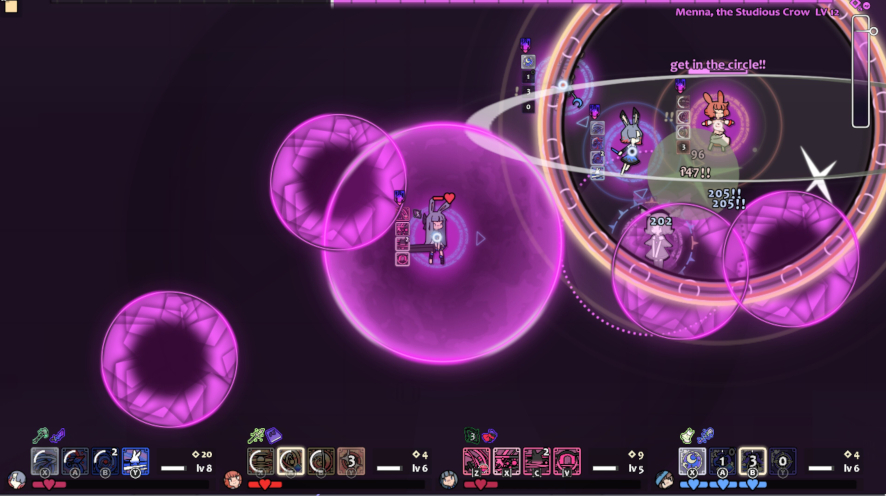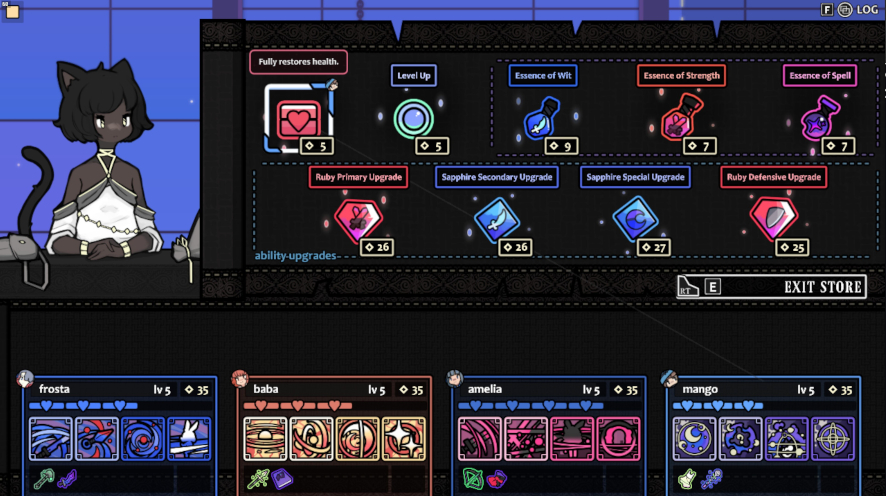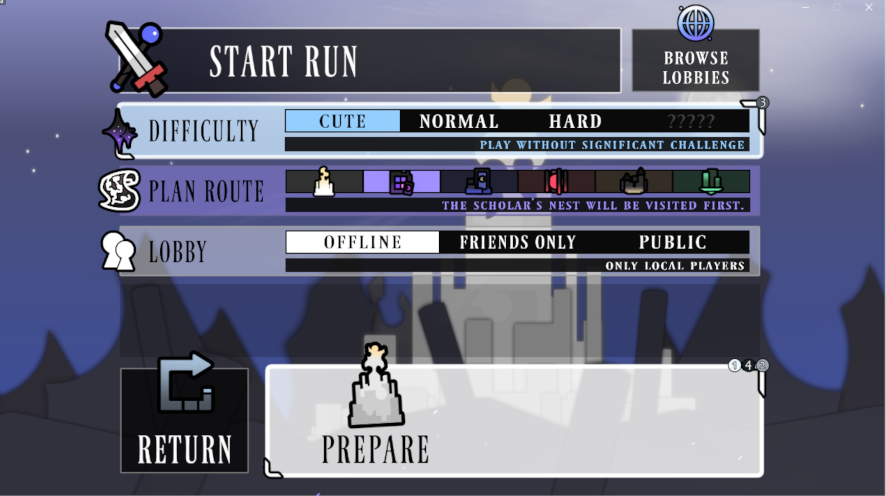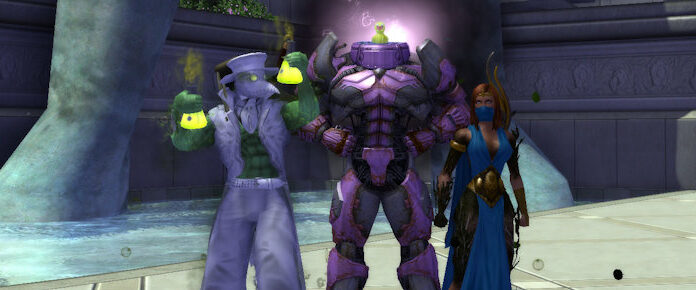
So here’s one that came out of left field for me. Rabbit and Steel (heretofore mentally referred to as Buns ‘n’ Blades) is an MMO raid-like designed around a party of four working together to defeat a series of bosses. It’s totally not my typical game. Yet the gameplay really clicks so well that I have had a ton of fun with it. After every run I’m ready to queue up for another.
Not to mention the art is so good. It has an almost Final Fantasy-esque vibe that I just love. All the characters and designs absolutely look so great. I’m a huge anime fan and obviously a gamer, but I’ve never particularly cared about the rabbit girl, cat girl, other cute animal girl combos. I don’t have anything against it, but I also don’t go looking for it. It’s cute here, though.
Now here’s the real kicker, and please lean in close because if my boss ever found out, she might give me the boot: I’ve never actually done a hardcore MMO raid before. [Probably making him the sanest of our writers. -Bree] I know I’m a devout MMO gamer, but I just never saw the need to jump into a raid. I’ve done plenty of dungeons, but full-scale, endgame raids? Nah. It’s true. It’s wildly unlikely and probably extremely heretical. Yet here we are, and maybe that places me near the bottom of the list for someone who should play and discuss how raid-like a game is. But regardless, I thought it was fantastic.
The coordination and amount of crap flying on the screen are what makes it raid-like
The main question you might have, or at least the one I always have when I hear of any game claiming to contain some key MMORPG element, is this: How is this a raid-like? How can a four player co-op claim to deliver a raid-like experience? Let’s dig into it.
Gameplay itself amounts to queuing up zones to run through and defeating boss stages. Every battle is simply a boss fight with the various mechanics you need to work together to get through. There aren’t any dumb mobs or dungeon like mechanics; it’s all boss fights. And while there is a very thin thread of story in the game, it’s really just there as fluff and doesn’t matter in the least.
In Rabbit and Steel, it all comes down to the amount of coordination your party needs and the boss attacks that mimic what players have come to expect from larger-scale raids. To wit: Don’t stand in the fire! Watch out! I’m a ticking time-bomb; don’t stand too close to me. Actually everyone come over here right now! And a bunch of other mechanics that really require group effort. It’s extremely hectic, and it’ll have you shouting out constantly to remind your mates where they need to be at anytime. At least, when playing with my party, I found it was a necessity – more on that later on.
Now, even though every fight amounts to being a boss battler, the end fight of a full zone is the real boss. This one is stronger and has more mechanics to deal with.
Character creation mimics MMOs too, sort of
You start by selecting from one of five classes: the assassin, druid, wizard, heavyblade, or dancer. You have four skills labeled as the primary, secondary, special, and defensive. It’s fairly self explanatory, but your first play gives you a very quick tutorial to click through each move and explain how to perform each one. The details of the attacks themselves aren’t discussed in depth; you’ll need to read the skill text closely and try them out to understand better, but it isn’t too hard to follow. You don’t have a ton of skills to use, either, but you need to use them at the right times – and constantly. So there’s definitely room to be a good player, and after every fight the game lists your DPS so you can also know how effective each player was (or wasn’t).
The tutorial is helpful in that it shows you which rings around yourself and your enemy are hitboxes and which are get-the-hell-away from boxes. While you my be swinging a sword around, you don’t need to make blade contact with the enemy portrait directly. Instead, you just need to get your AOE within the enemy’s hitbox. It sounds dumb to write it out, but in practice it makes sense and plays well.
Playing the game itself is a series of runs through the game’s zones. You have the option of planning your first zone, but from there I think everything is random – not in the procedurally generated kind of random, but random as in which zone comes next and which boss is fought.
Loot drops and shops allow you to customize your character
You don’t level up in any traditional RPG manner in Rabbit and Steel. So in that way it’s almost a roguelike rather than an MMO. You’re really just completing runs through the series of bosses and trying to be successful. If the party wipes, you’ll lose the loot you’ve earned and need to start over. Every run is essentially an encapsulated experience.
That means anytime you queue up, anyone you play with will always be on the same page as you. Plus, it means you’ll never outlevel anything, although as you learn the mechanics and improve your tactics, you’ll obviously out-skill the lower difficulties.
There are also stages that are simply for earning your loot. With a party of four, we always had five pieces of gear to choose from. There are a ton of different gear sets each with very unique abilities, basic additions like adding poison damage and so forth. But there are others that completely change the way your attacks work. And every few battles, you’ll also have a shop stage for a bit of reprieve.
Finally, as you defeat bosses and complete runs, you’ll unlock new gear that’ll become available in future runs as well as some hidden hero classes. Those new classes are the juiciest bit of carrot. It just makes me want to play more so I can unlock them. Another great thing about Rabbit and Steel is that unlocks can be completed as direct rewards – like “beat the game on Hard difficulty and unlock The Thing.” Heck, even if you can’t win on Hard, you’re still beating so many bosses that you should eventually be able to unlock everything. Fine design, I have to say.
Difficulty settings allow for gamers of all ranks and ages to enjoy playing together
Now, one of my favorite things about Rabbit and Steel is that it supports a fully local co-op team. Sure there is a queue so that you can play online with friends and randoms, but you can couch co-op all four players. That’s amazing. And that’s what elevates Rabbit and Steel into almost a party game for me.
In my playthroughs, I sat down with the fam, which currently consists of two adults and two elementary-school aged children. And if you haven’t ever tried to coordinate attacking a boss with a seven-year-old, hold your butts cause it is a ride. You know kids don’t listen, right? Also kids don’t love being yelled at to move here or there. They also, really, really, really, don’t love losing. Put it together and you’ve got a hell of a time. There’s shouting and often tears, but in the end it’s fun. “I loved it” and “It’s the best game ever” are what I heard after our first playthrough.
Of course, a large part of that is because Rabbit and Steel also offers a “Cute” difficulty mode. I believe you still have all the same mechanics to run through, but the bosses are softer, you’re given a larger starting health pool, and there’s a shorter respawn timer after getting knocked out. We didn’t have any full party wipes, just individual knockouts in Cute mode, so I’m not sure if it still kicks you back to the lobby when that happens or not. Either way, it’s a great addition for newbies and kids and folks who just want to play to relax instead of play to crush, and I’m really glad the developer didn’t try to overthink and design the game to be for hardcore players only, although it totally scales up for them. It’s very accessible for a wide range of player types, and that’s a huge plus.
Rabbit and Steel is currently available for PC only. Hopefully, there’s a path for console too because the controls are really designed around controllers, and the local co-op support places it perfectly in a console release position. Time to go join the 100,000 gamers already playing!
 Every other week, Massively OP’s Sam Kash delivers Fight or Kite, our trip through the state of PvP across the MMORPG industry. Whether he’s sitting in a queue or rolling with the zerg, Sam’s all about the adrenaline rush of a good battle. Because when you boil it down, the whole reason we PvP (other than to pwn noobs) is to have fun fighting a new and unpredictable enemy!
Every other week, Massively OP’s Sam Kash delivers Fight or Kite, our trip through the state of PvP across the MMORPG industry. Whether he’s sitting in a queue or rolling with the zerg, Sam’s all about the adrenaline rush of a good battle. Because when you boil it down, the whole reason we PvP (other than to pwn noobs) is to have fun fighting a new and unpredictable enemy!




















